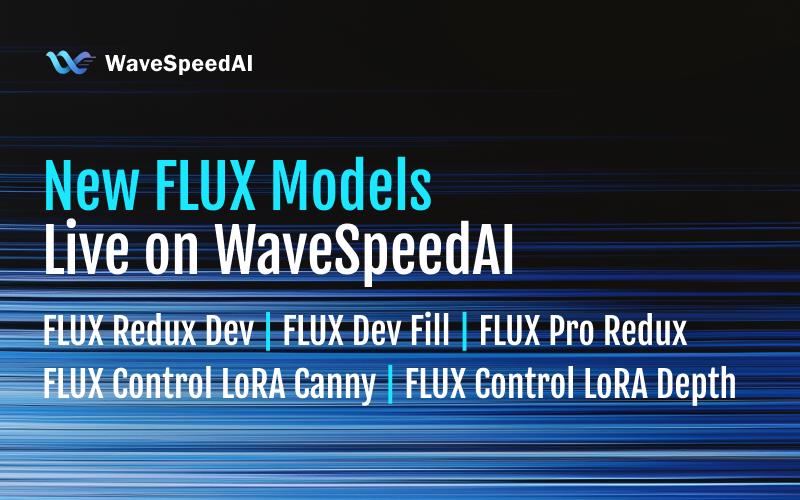Five New FLUX Models Live on WaveSpeedAI: From Creative Variations to Precision Control
This week, we’re introducing five new FLUX model endpoints—each tailored for a specific creative or structural task. Whether you’re looking to generate consistent image variations, apply advanced style transfers, or control generation with edge or depth maps, these models expand your creative toolkit with precision and speed.
Below is a breakdown of what each new endpoint offers, how it works, and potential application scenarios.

✨ FLUX Redux Dev
Model: wavespeed-ai/flux-redux-dev
Type: Image-to-Image (Open Weight)
FLUX Redux Dev is an open-weight image-to-image variation model designed to preserve the key structure of an input image while generating creative new variants. Built on the FLUX.1 development architecture, this model is ideal for experimentation and deployment in workflows requiring flexible, fast generation.
Key Features:
- Open weight model for flexible use and customization
- Maintains core elements of the original image
- Ideal for fast visual iteration across creative directions
Use Cases:
- Design exploration
- Content variation for A/B testing
- Visual experimentation in branding and illustration
🌀 FLUX Dev Fill
Model: wavespeed-ai/flux-dev-fill
Type: Image-to-Image
FLUX Dev Fill is a high-performance endpoint built on FLUX.1 [dev], optimized for rapid image transformation. It enables detailed style transfers and image modifications while maintaining the underlying image semantics. Dev Fill is ideal for high-speed, high-fidelity workflows during the prototyping phase.
Key Features:
- Fast style transfer with structural preservation
- Reliable output quality across diverse inputs
- Seamlessly integrates with the FLUX development stack
Use Cases:
- Visual style testing for media and entertainment
- Concept art and digital mockups
- High-volume creative workflows
🧩 FLUX Pro Redux
Model: wavespeed-ai/flux-pro-redux
Type: Image-to-Image
FLUX Pro Redux is the professional-grade endpoint of the FLUX.1 [pro] architecture. It provides enhanced fidelity and control for image-to-image transformations, preserving semantic meaning and visual consistency. It’s designed for use in demanding environments where output quality must meet production standards.
Key Features:
- High-resolution generation with stable structure
- Precision in visual consistency and style
- Tailored for professional creative pipelines
Use Cases:
- Product design visualization
- Marketing asset creation
- Concept development for film, fashion, and media
🖋️ FLUX Control LoRA Canny
Model: wavespeed-ai/flux-control-lora-canny
Type: Image-to-Image (Control Image Input: Canny Edges)
FLUX Control LoRA Canny enables precise structure control via Canny edge maps. This endpoint interprets edge input as a guide for composition, allowing users to direct the generated content using structural sketches. It’s particularly useful for workflows that begin with shape or silhouette design.
Key Features:
- Uses Canny edge maps for structural guidance
- Supports detailed generation with accurate outline adherence
- Integrates with LoRA for enhanced control
Use Cases:
- Sketch-to-image generation
- Industrial design concepts
- Visual development in animation and comics
🌐 FLUX Control LoRA Depth
Model: wavespeed-ai/flux-control-lora-depth
Type: Image-to-Image (Control Image Input: Depth Map)
FLUX Control LoRA Depth uses depth maps to guide image generation, allowing for realistic perspective, spatial relationships, and 3D-aware composition. The model is optimized for scenarios where depth cues significantly influence the final output.
Key Features:
- Depth-guided image generation
- Preserves spatial coherence and camera perspective
- Robust output with layered composition
Use Cases:
- Scene layout for visual storytelling
- 3D-to-2D conversion workflows
- Architectural visualization and interior concept design
Each of these endpoints enhances the modularity of the FLUX stack and offers new tools for creative and technical professionals alike. You can explore and test them directly via WaveSpeedAI model store or integrate them into your own pipelines using our API.
Follow us on Twitter, LinkedIn and join our Discord channel to stay updated.
© 2025 WaveSpeedAI. All rights reserved.
